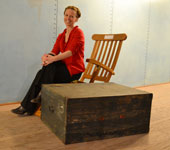Things started getting complicated for English immigrant Jennifer Frances Taylor’s young family after they settled in Canada in June of 1950.
“Soon after Labour Day, school started for John and Roger,” Jennifer wrote. “It was very strange in many ways, but the kindliness and friendliness of teachers and children helped a lot.
“Alas, however, they didn’t go for more than a week before Martin & John developed unusual coughs which we realized with horror was whooping cough. This caused a tremendous flap in the district and the doctor insisted that we should have a large quarantine label on our door warning all children to keep their distance.
“I found this a little hard to bear as I had never been one to let my children loose with infectious diseases. However, I reasoned, how were people to know that?”
“John had a very slight attack, Roger by some miracle escaped, but Martin became quite ill. The doctor ordered one of the antibiotics at $1.00 per pill. With our shaky financial state, this was indeed a blow as my husband had not yet started work.
“If you have ever tried to give pills worth a dollar each to a child with violent whooping cough, you will know the trials and anxieties we went through! However, they were very worthwhile and the worst was over in a few days. After several weeks, Martin was free to play again and John returned to school.
“This, of course, stopped our getting to know people for a while although some came and talked to us on the porch. I will always remember Dr. Whidden bringing us huge box of the most delicious pears on his son’s coaster wagon.”
Does anyone else feel like the end of that story could have been written yesterday. Enjoy shouting at your neighbours from your porches and cherish the giving and receiving of small gifts.
Canadian Museum of Immigration at Pier 21 (S2012.1600.1)
